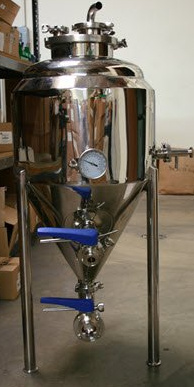I do not intend to press you for information you are obligated to keep confidential, so no worries. I can still likely help you without knowing it. 
I will also not try to convince you not to do something you believe has merit, even if it seems to differ from my understanding through my own empirical data. In this case, it would be your Winterization process after cryo-ethanol extraction of your biomass. However, since all that really entails or requires is the separation of the bulk of the marc (solvent-wet biomass) from your solution, I adamantly recommend you use nylon mesh filter bags (generic all-mesh Bubblebags) to pull the bulk marc out of the solvent, let it drain a bit, then centrifuge it to get the vast majority of your ethanolic solution out of the marc. Speaking of which…
CENTRIPETAL FILTRATION TEK
…a photon_noir production, exclusively published here on future4200.com… 
Since you should be using a large basket centrifuge to get all your ethanolic extraction solution out of the marc, you could ostensibly utilize that large artificial gravitational force more efficiently by lining the basket with a few concentric layers of filter paper or membrane material. The finest pore material would be against the metal interior wall of the basket, and successively larger pore size materials would follow over it and one another. Cut each membrane a little long so it overlaps itself a bit, and place this seam away from your last seam by 180° if using only 2 layers, 90° for 4 layers, 45° for 8 layers, etc. (Just divide 360° by the number of layers you will use to find the degree offset for the seams.) to balance the weight distribution around the basket.
You can use a stainless steel screen fitted to perfectly cover (preferred) or very slightly overlap the inside circumference of the cylinder, which will be slightly smaller as the thickness of your filter cake increases, and rolled into a C shape a bit larger than your basket interior to form a flat spring brace. Also use a neoprene (foam is probably easiest to find and best to work with), buna (nitrile), viton, silicone or other ethanol-resistant rubber slip-over gasket strip (you can make one out of tubing, but solid core is best) to line the bottom edge of the screen, and the top edge if you want to be thorough, effectively gasketing your filter cake against particle leaks around the sides of the membranes. You should also gasket the inner overlapping edge of the screen if you overlap it, so as to avoid the sharp edges cutting your filter bags. Your coarsest filtration will be performed by the mesh bag (or multiple, successively smaller pore size bags) containing the herb.
The more layers, the faster the filtration, but also the greater the holdup loss of solution, so you will find a good balance. Much of the holdup loss can be mitigated by using the right materials, however. It can be initially costly, but using PTFE or other ethanol-proof polymer (like nylon) fabrics and membranes instead of cellulose or paper reduces holdup and they can be reuseable by careful washing from the opposite side… One way to clean is to place each membrane alone in the centrifuge basket, with the originally inner surface now facing out against the metal wall (or better would be a thin towel or sheet of fabric), brace it with the screen, turn on the spinner, and spray down the membrane with clean ethanol while it spins.
Think of it as an organized or structured filter cake using gravity instead of vacuum (atmospheric pressure) as the force driving the liquid through it. Gravity (centripetal force) is excellent for filtration, because, unlike vacuum, it does not cause your solution to evaporate underneath the finest pores or within the filter layercake. It is similar to pressure filtering, but actually more perfectly tuned to your incrementally smaller pores by the simple fact that the material furthest from the center has the most angular velocity and thereby force applied to it.
And in case you were wondering, yes, you should be able to use this in place of a Buchner, Nutsche, or other pressure filtration device to filter the bulk of your extract solution. 
Using this method, the ethanolic solution obtained from the centrifuge should be free of all plant (or other???) sediments and ready for solvent recovery, but if you think Winterizing it will precipitate something, by all means, refreeze it… Just do NOT add it back to the extraction cryo-vessel full of sedimenty ethanol. Maybe just put it in a cryofreezer to check if it truly has dissolved material you can cold-precipitate.
Just fyi, centrifugation can cause evaporation by multiple effects: One is the physical force of momentum being greatest on the densest matter (solids, lower temperature liquids) and weakest on the least dense matter (vapors, higher temperature liquid). Another is the air vortexing in the center and around the basket, forcefully blow-drying everything.
Consolidation of processes, improving efficiency is one of the hallmarks of effective scaling. 



